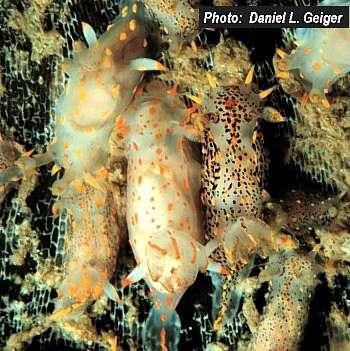
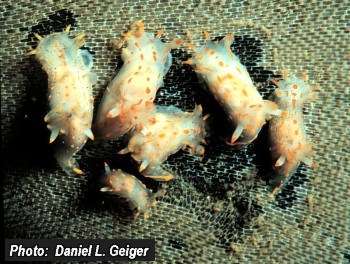
Polycera quadrilineata
(Muller, 1776)
Order: NUDIBRANCHIA
Suborder: DORIDINA
Family: Polyceridae
Subfamily: Polycerinae
DISTRIBUTION
Western Europe from Iceland and Greenland south to the Mediterranean (Italy, France, Spain, Turkey).
PHOTO
UPPER: Feeding on Membranipora membranacea on Laminaria digitata in Laminarian algae belt. United Kingdom, Wales, Swansea, Oxwich wreck, 24 June 1993, 1.2 metres. PHOTOS: Daniel G. Geiger. See message for further photos of colour variation and egg masses
This common European polycerid grows to about 40 mm in length. It is white with blotches of yellow or orange. Sometimes black spots or speckling can be present. The orange marks usually from a line down the dorsal midline, with others in the sides and dorsal part of the posterior foot. In some animals, as illustrated here, black or dark blue speckling occurs. The rhinophores, gills and tentacles are tipped with orange, and in some cases the gills are edged in orange. There usually four pointed papillae around the anterior (head end) of the mantle. It feeds on ectoproct bryozoans, especially Membranipora membranacea, but is also reported from a number of other species.
There is a dark blue form of Polycera quadrilineata which closely resembles the blue adult form of Polycera aurantiomarginata. P. aurantiomarginata always has an orange border to the foot as its name suggests. The two species can also be distinguished in the colour of the rhinophore club - in P. aurantiomarginata at least the upper half, but not the tip is bluish-black, and in P. quadrilineata, yellow or orange. Similarly the apical part of the gills are black in P. aurantiomarginata and yellow in P. quadrilineata. Another difference is in the number of cephalic processes on the anterior mantle edge - - in P. aurantiomarginata there are 6-7 and in P. quadrilineata usually 4.
Reference:
• Thompson, T.E. & Brown, G.H. (1984) Biology of Opisthobranch Molluscs, Vol 2. Ray Society: London.
Rudman, W.B., 1999 (August 5) Polycera quadrilineata (Muller, 1776). [In] Sea Slug Forum. Australian Museum, Sydney. Available from http://www.seaslugforum.net/find/polyquad
Related messages
Re: Thecacera? or Polycera? species - From Ratnagiri, India
May 11, 2009
From: Vishal Bhave
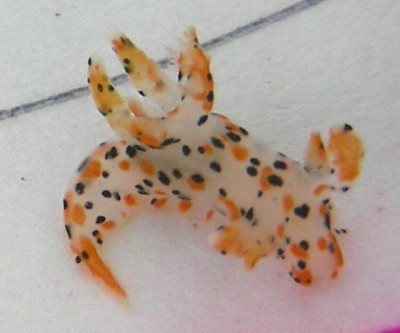
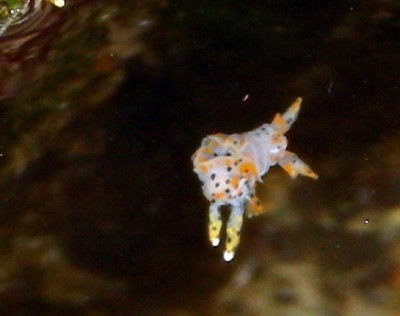
Concerning message #7813:
This was found in a rockpool, suspended upside down at the surface.
Locality: Rocky patch, Mandavi, Ratnagiri, 0 Feet, Maharashtra, India, Arabian sea, 27 October 2008, Intertidal, rocky, with lots of algae, sponge, hydrozoans and bryozoans and in some rock pools corals (Carijoa sp.). Length: 9 mm. Photographer: Vishal Bhave.
Vishal Bhave
vishalbhave@gmail.com
Bhave, V.J., 2009 (May 11) Re: Thecacera? or Polycera? species - From Ratnagiri, India. [Message in] Sea Slug Forum. Australian Museum, Sydney. Available from http://www.seaslugforum.net/find/22423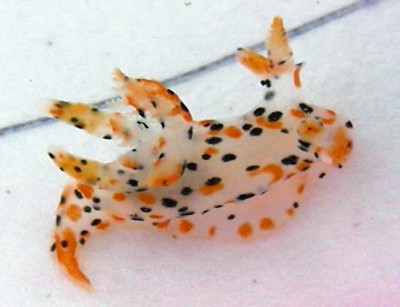
Dear Vishal,
This is the ubiquitous Thecacera pennigera. First described from the North Atlantic we now have records of it from many places around the world. As a bryozoan feeder, we assume it has spread on the bottom of boats or perhaps in ballast water. There is an old record from Pakistan but as far as I can find none as yet from India, so this is a valuable find.
Best wishes,
Bill Rudman
Polycera quadrilineata and bryozoans
April 24, 2008
From: Joao Pedro Tojal Loia Soares Silva
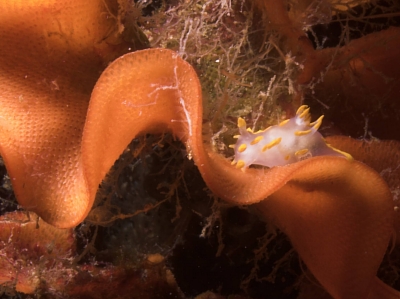
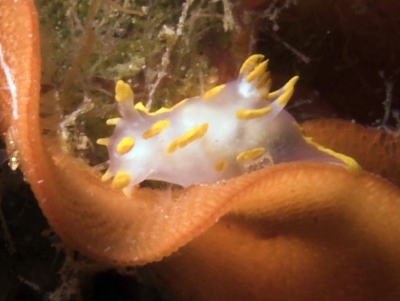
Dear Bill,
During this week, Polycera quadrilineata was probably the most frequently observed nudibranch. This one was found crawling over a bryozoan (making a nice set for photography). Could it be its food?
Locality: Sesimbra, 25 m, Portugal, North Atlantic, 19 September 2007, Rocky bottom. Length: 1cm. Photographer: Joao Pedro Silva.
Cheers,
Joao Pedro
jpsilva@uwphotographer.net
Silva, J. P., 2008 (Apr 24) Polycera quadrilineata and bryozoans. [Message in] Sea Slug Forum. Australian Museum, Sydney. Available from http://www.seaslugforum.net/find/20800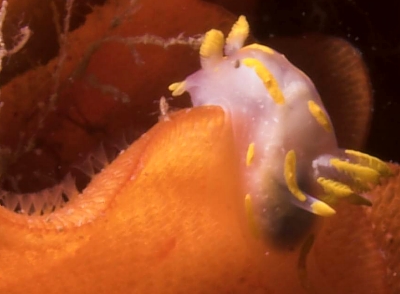
Dear Joao Pedro,
I would say this orange bryozoan is almost certainly its food.
Best wishes,
Bill Rudman
Re: Ancula gibbosa from Scotland
June 15, 2006
From: Jim Anderson
Concerning message #16871:
Dear Bill,
Thank you for the clear explanation of the differences. This will be a great help to me in sorting out the Anculas from the Polycerids - I seem to be able to separate the 'faeros' from the 'quads'. Apart from the head processes, Polycera faeroensis always appear 'fatter' and a more opalescent white, than P. quadrilineata, but I have found examples that are only differentiated by the head processes. Unfortunately I don't get to see these species often enough to be really familiar with them.
Regards,
Jim A
jander4454@gmail.com
Anderson, J., 2006 (Jun 15) Re: Ancula gibbosa from Scotland. [Message in] Sea Slug Forum. Australian Museum, Sydney. Available from http://www.seaslugforum.net/find/16874Re: Ancula gibbosa from Scotland
June 14, 2006
From: Jim Anderson
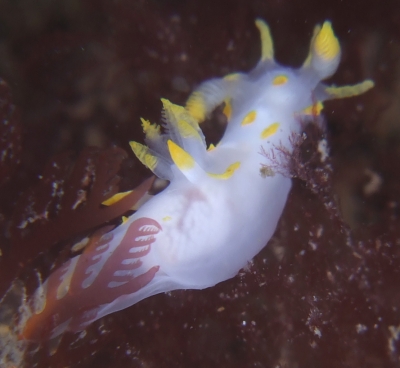
Concerning message #16821; #16863:
Dear Bill and Marina,
Thank you for the update and correction. I attach the 3 original jpegs
at the max resolution - perhaps these will assist.
By the way what are the significant ID characteristics between A. gibbosa and Polycera quadricolor? I don't think it is P. faeroensis
Regards,
Jim A
jander4454@gmail.com
Anderson, J., 2006 (Jun 14) Re: Ancula gibbosa from Scotland. [Message in] Sea Slug Forum. Australian Museum, Sydney. Available from http://www.seaslugforum.net/find/16871Dear Jim,
I only need to post your third photo, which you didn't send with your first message. Fortunately it solves the identity problem.
As to separating the three species. There are many internal anatomical differences between species of Ancula and species of Polycera, and fortunately there are a few external ones as well. Firstly, in species of Polycera, there is an extension of the mantle edge into an 'oral veil' over the head, at the anterior end. The edge of this oral veil has a number of tentacular processes which point out horizontally and are arranged in equal numbers on each side of the midline. Species of Polycera usually have a single lateral process alongside each gill, but this is not always a clear distinction, because related polycerids may have a number of processes alongside the gills.
In Ancula, their is no oral veil, there are two forward facing tentacular processes arising from the base of each rhinophore, and their are a number of lateral processes arranged on each side of the body, alongise and just behind the gills. Bernard Picton has sent in a nice photo [message #3910] of a yellow patterned example of Ancula gibbosa from Britain. The simplest difference from polycerids is the lack of an oral veil so the head is clearly visible from above.
In you two earlier photos the oral veil was not visible as the anterior end of the animal was facing down. Fortunately your photo here shows the oral veil quite clearly so we can be sure it is a Polycera. It is possible to distinguish P. quadrilineata from P. faeroensis, by using external characters but as both species are quite variable in colour, most of the colour pattern is not that useful. However the best distinction is that P. quadrilineata usually has 4 (rarely 6) oral veil processes, while P. faeroensis usually has 8 or more. As you animal has 4 long oral veil processes I am pretty sure it is P. quadrilineata.
Best wishes,
Bill Rudman
Re: Ancula gibbosa from Scotland
June 14, 2006
From: Marina P. Ossokine
Concerning message #16821:
Dear Bill and Jim,
This animal is Polycera, not Ancula because it has only one pair of branchial processes. It could be either Polycera quadrilineata or Polycera faeroensis, but to be sure we'd need to know how many head processes it has.
Best regards,
Marina.
nembro@nembro.info
Poddubetskaia Ossokine, M., 2006 (Jun 14) Re: Ancula gibbosa from Scotland. [Message in] Sea Slug Forum. Australian Museum, Sydney. Available from http://www.seaslugforum.net/find/16863Dear Marina,
I am very glad you were paying attention! You are of course quite right, this is not an Ancula but a species of Polycera. I must have been on autopilot when I prepared this message. Jim Anderson has got photos of Ancula gibbosa, Polycera quadrilineata and Polycera faeroensis, all with an extremely similar colour pattern on his excellent website at:
http://www.scottishnudibranchs.co.uk/
I have emailed Jim who has sent his only other photo of this animal [see message #16871] which shows it is Polycera quadrilineata.
Best wishes,
Bill Rudman
Ancula gibbosa from Scotland
June 12, 2006
From: Jim Anderson
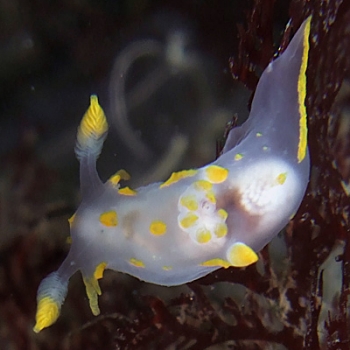
Note added 14 June 2006: This is Polycera quadrilineata. See message #16871.
Dear Bill
Here are a couple of images from Scotland of the yellow and white colour from of Ancula gibbosa..
Locality: The Slate Wreck, Sound of Mull, 19 m, Scotland, West coast, NE Atlatic, 3 June 2006, Sand, gravel, stone. Length: 25 mm. Photographer: Jim Anderson.
Jim Anderson
jander4454@gmail.com
Anderson, J., 2006 (Jun 12) Ancula gibbosa from Scotland. [Message in] Sea Slug Forum. Australian Museum, Sydney. Available from http://www.seaslugforum.net/find/16821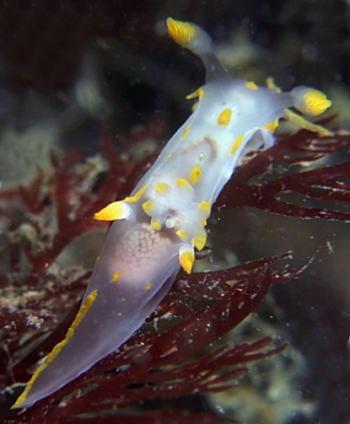
Thanks Jim,
I hope the coverage of colour forms we now have on the Forum from both sides of the north Atlantic and north Pacific will whet someone's appetite to study them in more depth.
Best wishes,
Bill Rudman
Polycera quadrilineata or Trapania tartanella ?
June 8, 2006
From: Stephane Ores
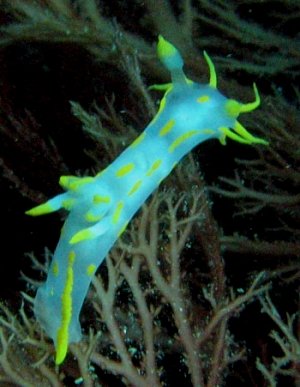
Dear Bill
I saw this seaslug on a red alga, which looks like Polycera quadrilineata but it has some papillae near the branchiae, which make me wonder if it is Trapania tartanella..
Locality: St Cast, northern Brittany, France, 8 m, Brittany, France, Channel, Atlantic Ocean, 05 june 2006, Good visibility. Length: 25 mm. Photographer: Stephane Ores
Thanks for your help
Stephane
stephane.ores@neuf.fr
Ores, S., 2006 (Jun 8) Polycera quadrilineata or Trapania tartanella ?. [Message in] Sea Slug Forum. Australian Museum, Sydney. Available from http://www.seaslugforum.net/find/16814Dear Stephane,
This is Polycera quadrilineata and it does look similar in colour to Trapania tartanella. Both have a single papilla alongside the gills, but there are major differences at the head end of the body. Species of Trapania have a pair of recurved lateral papillae, one on each side of the rhinophores. Also in Trapania there is no mantle edge forming a cover over the head, so the head and its pair of oral tentacles are clearly visible. In Polycera the mantle skirt is really only apparent around the anterior end of the body and it has a series of fairly large pointed papillae along its edge, which you can see in your photo. In Polycera, the 'head' is hidden beneath the mantle skirt.
Best wishes,
Bill Rudman
Polycera quadrilineata from Portugal
March 2, 2004
From: Joao Pedro Silva
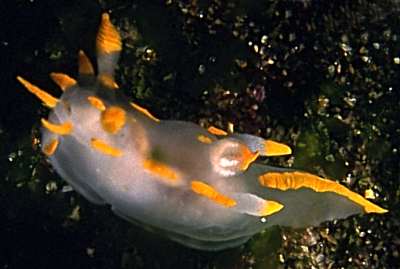
Dear Bill,
Last weekend I came accross this nudibranch which I think is Polycera quadrilineata. At first I thought it was Trapania tartanella, which I have seen previously in Baleal, Portugal, but then I noticed the yellow stripes on the body and these didn't match my previous sighting.
Could you confirm this?
All the best,
Joao Pedro
http://uwphoto.no.sapo.pt
jpsilva@uwphotographer.net
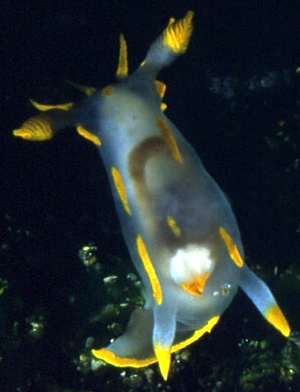
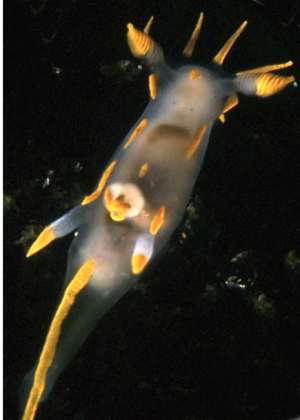
Dear Joao Pedro,
Yes this is Polycera quadrilineata. Your lower two photos show how transparent this animal can be. The curved brown tube you can see is the intestine full of waste material. It leads back to the anus which opens in the centre of the gills. JUst in fromt of the intestine you can see two small black specks, which are the eyes. The large white mass in front of the eyes is the muscular buccal bulb which contains the ribbon of radular teeth used to 'bite off' pieces of food.
Best wishes
Bill Rudman
Polycera quadrilineata from Turkey
August 23, 2003
From: Ferda Buyukbaykal
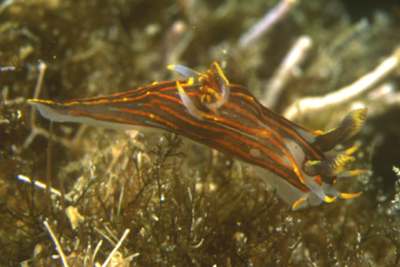
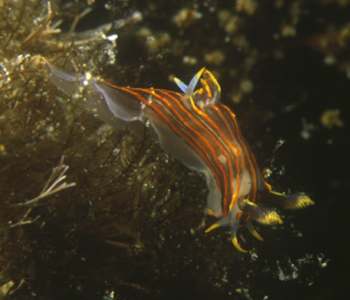
Dear Bill,
Could you confirm that this is Polycera quadrilineata please
Date: May 18 , 2003
Location: Antalya, Tekirova
Site: Uc adalar
Depth: 5-8 mt
Size: 25-30 mm
Photos: Ferda Buyukbaykal
Best regards
Ferda
ferdabbaykal@isnet.net.tr
Buyukbaykal, F., 2003 (Aug 23) Polycera quadrilineata from Turkey. [Message in] Sea Slug Forum. Australian Museum, Sydney. Available from http://www.seaslugforum.net/find/10814Dear Ferda,
Yes this is the dark form of Polycera quadrilineata
Best wishes,
Bill Rudman
Polycera quadrilineata from northern Spain
July 12, 2003
From: Ricardo Roberto Fernández
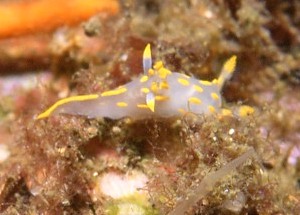
Dear Dr.Rudman,
First of all, congratulations for such wonderful site. I am identifying all my slides of nudibranchia and I have some problems with the ones I include with the photographs.
I think is Polycera quadrilineata. The species was recorded at Cabo Peñas, on the Northern coast of Spain. It was about 5 metres deep.
Thank you very much for your help.
Yours faithfully,
Ricardo Roberto Fernández.
Asturias (nthn Spain)
rirober@telecable.es
Fernández, R.R., 2003 (Jul 12) Polycera quadrilineata from northern Spain. [Message in] Sea Slug Forum. Australian Museum, Sydney. Available from http://www.seaslugforum.net/find/9781Dear Ricardo,
Yes this is Polycera quadrilineata. Sorry it's taken a while to answer this query but despite my best efforts the backlog of messages doesn't seem to shorten
Best wishes,
Bill Rudman
Polycera quadrilineata from Turkey
May 29, 2003
From: Haluk Akbatur
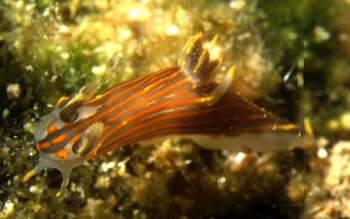
Dear Bill,
Here is another nudi from Uc Adalar, East coast of Turkey. I have read the different messages and replies about the difference between Polycera quadrilineata and ,Polycera aurantiomarginata recently. I have some difficulty in identifying this dorid. Is it a Roboastra luteolineata or Polycera sp.? Specimens were seen on 18 May 2003, Dive site: Uc adalar (South-west of Turkey, Mediterranean coast,] Size: 1.5 cm, Depth:3-5m.
There are some yellow marks along the edge of the foot. Could you confirm it is Polycera quadrilineata please?
Haluk Akbatur
Lasergoz@ttnet.net.tr
Akbatur, H., 2003 (May 29) Polycera quadrilineata from Turkey. [Message in] Sea Slug Forum. Australian Museum, Sydney. Available from http://www.seaslugforum.net/find/10053Dear Haluk,
Firstly, the long papillae or tentacles around the front of the head are a sign that it is most probably a species of Polycera rather than a species of Roboastra. As to which species you have. As you say P. aurantiomarginata always has an orange border to the foot as its name suggests. But if you look at Jean-Pierre Bielecki's message, it seesm a few yellow spots along the edge of the foot are sometimes present in P. quadrilineata.
The two species can also be distinguished in the colour of the rhinophore club - in P. aurantiomarginata at least the upper half, but not the tip is bluish-black, and in P. quadrilineata, yellow or orange. Similarly the apical part of the gills are black in P. aurantiomarginata and yellow in P. quadrilineata. In you animal, both these characters match the colour pattern for P. quadrilineata. See also the discussion concerning Baki's photos from the same locality
Best wishes,
Bill Rudman
Re: Unknown dorid from French Brittany
September 23, 2002
From: Juan Lucas Cervera
Dear Bill,
Concerning Marina's mystery dorid. I have not seen juveniles of Thecacera pennigera, but this animal reminds me of it. Nevertheless, I don't see the typical rhinophoral leaves of Thecacera. So... I don't know if they are always present or develop as the animal grows.
Cheers.
Lucas.
lucas.cervera@uca.es
Cervera, J.L., 2002 (Sep 23) Re: Unknown dorid from French Brittany. [Message in] Sea Slug Forum. Australian Museum, Sydney. Available from http://www.seaslugforum.net/find/7991Thanks Lucas,
There certainly is a similarity to Thecacera. Interestingly Bernard Picton has just posted a message confirmimg it as a juvenile of Polycera quadrilineata and noting that Alder & Hancock described this juvenile colour form as a species of Thecacera - Thecacera capitata.
Best wishes,
Bill Rudman
Re: Unknown dorid from French Brittany
September 23, 2002
From: Bernard Picton
Hi Bill,
Yes, I can confirm that this is a juvenile of the 'spotty' form of Polycera quadrilineata. Note that an animal was named as Thecacera capitata by Alder & Hancock, which Thompson considered to be this form of P. quadrilineata, so if anyone finds something like this with rhinophore sheaths.....
Bernard
bernard.picton.um@nics.gov.uk
Picton, B. E., 2002 (Sep 23) Re: Unknown dorid from French Brittany. [Message in] Sea Slug Forum. Australian Museum, Sydney. Available from http://www.seaslugforum.net/find/8012Thanks Bernard,
Bill Rudman
Unknown dorid from French Brittany
September 18, 2002
From: Marina Poddubetskaia
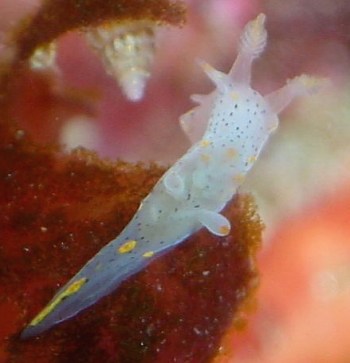
Dear Bill,
I have some difficulty in identifying this dorid. Is it a Polycera species?
Thanks a lot for your help.
Date: August 17, 2002
Location: Belle-ile, French Brittany, Atlantic Ocean
Site: Piler de Bagen Hir
Depth: 14m
Size: 6-8mm
Best wishes,
Marina.
nembro@nembro.info
Poddubetskaia, M., 2002 (Sep 18) Unknown dorid from French Brittany. [Message in] Sea Slug Forum. Australian Museum, Sydney. Available from http://www.seaslugforum.net/find/7813Dear Marina,
Perhaps this is a juvenile of Polycera quadrilineata? I am sure someone will help us out.
Best wishes,
Bill Rudman
Polycera quadrilineata from French Brittany
September 3, 2002
From: Marina Poddubetskaia
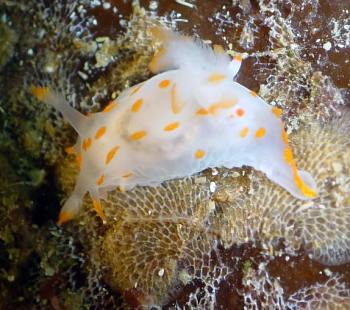
Dear Bill,
Here is a photo of Polycera quadrilineata from Atlantic Ocean.
Date: August 16, 2002
Location: Belle-ile, Brittany, France [Atlantic Ocean]
Site: Penhouet
Depth: 10m
Size: 20-25mm
Photos: Marina Poddubetskaia - Nembro website
Best wishes,
Marina.
nembro@nembro.info
Poddubetskaia, M., 2002 (Sep 3) Polycera quadrilineata from French Brittany. [Message in] Sea Slug Forum. Australian Museum, Sydney. Available from http://www.seaslugforum.net/find/7867Thanks Marina,
This species is certainly quite variable in colour pattern.
Best wishes,
Bill Rudman
Polycera quadrilineata from France
July 23, 2002
From: Marina Poddubetskaia
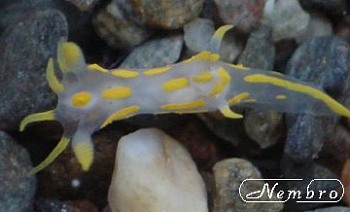
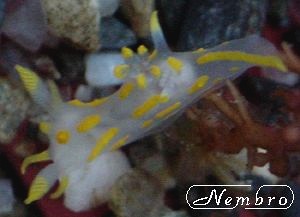
Dear Bill,
Here are some photos of Polycera quadrilineata. This animal was found on algae Sphaerococcus coronopifolius.
Cerbere, France [Mediterranean coast], Site: La Ramere, Depth: 10m, Size: about 10mm. July 05, 2002.
Photos: Marina Poddubetskaia - Nembro website
Best wishes,
Marina.
nembro@nembro.info
Poddubetskaia, M., 2002 (Jul 23) Polycera quadrilineata from France. [Message in] Sea Slug Forum. Australian Museum, Sydney. Available from http://www.seaslugforum.net/find/7520Thanks Marina,
Bill Rudman
Re: Polycera quadrilineata
June 20, 2002
From: Jean-Pierre Bielecki
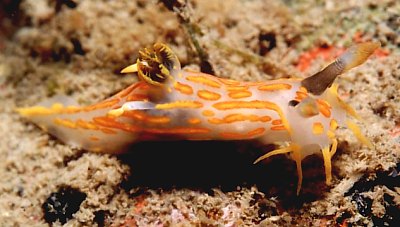
Hi Bill,
Thank you and Lucas for explaining the difference between Polycera quadrilineata and P. aurantiomarginata. It's now very clear. I add one other picture of P. quadrilineata because it has more than four cephalic processes - really nothing in the knowledge of these animals is very simple !!!
Size: 15mm, depth: 6m, Dive site: Sète, étang de Thau [Mediterrean coast, France] in March 2001.
Regards.
Jean-Pierre Bielecki
bielecki.jeanpierre@free.fr
Bielecki, J.P., 2002 (Jun 20) Re: Polycera quadrilineata. [Message in] Sea Slug Forum. Australian Museum, Sydney. Available from http://www.seaslugforum.net/find/7296Thanks Jean-Pierre,
I'm glad I said "usually 4" cephalic processes in P. quadrilineata.
Bill Rudman
Re: P. quadrilineata or P. aurantiomarginata?
June 19, 2002
From: Juan Lucas Cervera
Dear Jean-Pierre,
Your animals are Polycera quadrilineata.
P.S. Since you are living in France, probably you could be able to get the original description for Polycera aurantiomarginata in Cahiers de Biologie Marine (1984).
Cheers.
Lucas.
lucas.cervera@uca.es
Cervera, J.L., 2002 (Jun 19) Re: P. quadrilineata or P. aurantiomarginata?. [Message in] Sea Slug Forum. Australian Museum, Sydney. Available from http://www.seaslugforum.net/find/7301Polycera quadrilineata or P. aurantiomarginata?
June 18, 2002
From: J-P. Bielecki
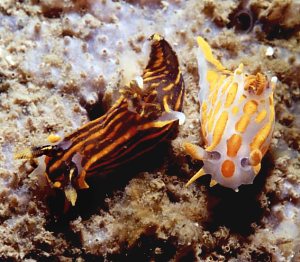
Hi Bill
Here is a photo of what I supposed to be Polycera quadrilineata with the two color variation and crawling together. But after seen the Polycera aurantiomarginata species from Baki Yokes, I am not sure about my first ID. Could you please give the keys characteristics to distinguish these two species.
Species seen in April 2000, Dive site: Sète, étang de Thau, [Mediterranean coast, France] Size: 2cm, Depth:6m.
Regards,
Jean-Pierre
bielecki.jeanpierre@free.fr
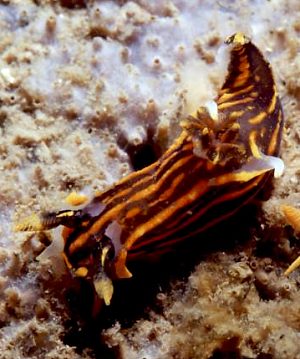
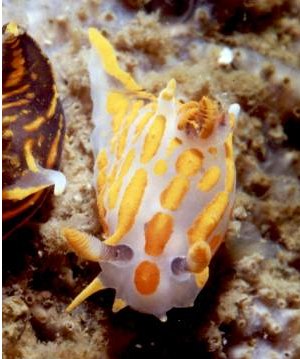
Dear Jean-Pierre,
Thanks for the photo. I too am puzzled with these two species. I have asked Lucas Cervera for guidance
Bill Rudman
Re: Polycera aurantiomarginata? from Turkey
June 18, 2002
From: Juan Lucas Cervera
Hi Bill,
I'm not sure if this species is P. aurantiomarginata. I am not sure if there are some orange marks along the edge of the foot of the upper animal, but it's not clear. This feature give the specific ethymology. I have seen also some specimens of P. quadrilineata with a colour pattern quite similar to Baki's animals.
Lucas.
lucas.cervera@uca.es
Cervera, J.L., 2002 (Jun 18) Re: Polycera aurantiomarginata? from Turkey. [Message in] Sea Slug Forum. Australian Museum, Sydney. Available from http://www.seaslugforum.net/find/7281Dear Lucas,
Any help you can give will be welcome. I am afraid I am unable to quickly get hold of a copy of the original description of P. aurantiomarginata. Is a yellow line along the edge of the foot the only external character separating P. aurantiomarginata from the blue colour form of P. quadrilineata? I note that in Alma Sánchez's photo of Polycera aurantiomarginata there is dark blue on the rhinophore club and on the gills. What about the papillae on the anterior mantle veil. I see P. quadrilineata have 4 and Alma's specimen of P. aurantiomarginata has 6. Is this a good character?
It is puzzling that what seems to be a very similar animal is identified in Ocaña Martin et al, 2000 as P. quadrilineata.
Thanks,
Bill
Re: Polycera aurantiomarginata from Turkey (2)
June 18, 2002
From: Lucas Cervera
Dear Bill,
In Ocaña Martin et al, 2000 there is a juvenile of Polycera aurantiomarginata [p. 242] and photos of two different color patterns of Polycera quadrilineata [p. 240-241]. That on the page 241 resembles very much Baki's animal.
P. aurantiomarginata can show variability in its coloration, but always has an orange band, that can be interrupted or not, all along the edge of the foot (the etymology of the specific name refers to this), the laminate part of the rhinophores or at least the apical part (except the tip that can be translucid) is black without other color; the apical part of the gills are black, at least the tips of the cephalic and extrabranchial process are orange. Concerning the number of the cephalic processes - in P. aurantiomarginata there are (6-7) and in P. quadrilineata (4).
I hope this can be help you. I'm consider that the Baki's animal is more a P. quadrilineata than P. aurantiomarginata, but I cannot be sure beacuse I cannot see the edge of the foot clearly.
Regards.
Lucas.
lucas.cervera@uca.es
Cervera, L., 2002 (Jun 18) Re: Polycera aurantiomarginata from Turkey (2). [Message in] Sea Slug Forum. Australian Museum, Sydney. Available from http://www.seaslugforum.net/find/7292Dear Lucas,
Thanks for your rapid response. I'm afraid I haven't a copy of the original description of P. aurantiomarginata easily available. On looking through the photos you mention and Jean-Pierre's showing white and blue colour forms of P. quadrilineata, I was wondering whether the rhinophore and gill colours and the number of cephalic processes were useful. Unfortunately, in most photos, the edge of the foot is hidden. I'm sure you are correct in identifying Baki's animal as Polycera quadrilineata.
best wishes,
Bill Rudman
Polycera aurantiomarginata? from Turkey
June 16, 2002
From: Baki Yokes
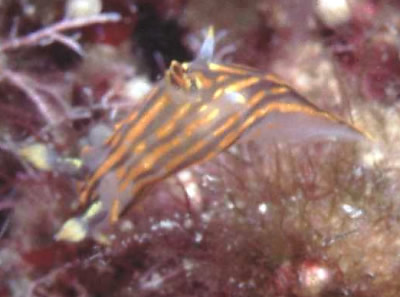
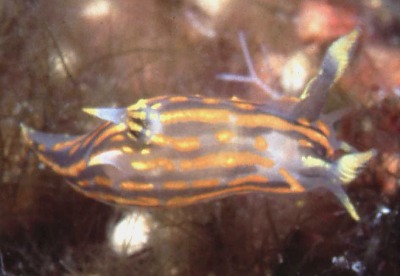
Dear Bill,
This specimen looks like a Polycera quadrilineata. But it has a different colouration than the ones in Daniel Geiger's message. What is your opinion?
photo: Taken by Baki Yokes
Place: Antalya, Turkey
Dive site: Uc Adalar
Date: 3 May 2002
Depth: 15m
Size: 15mm
Best wishes
Baki
bakiyokes@turk.net
Yokes, B., 2002 (Jun 16) Polycera aurantiomarginata? from Turkey. [Message in] Sea Slug Forum. Australian Museum, Sydney. Available from http://www.seaslugforum.net/find/7166Note: This is Polycera quadrilineata. See message from Lucas Cervera
Dear Baki,
It is indeed a species of Polycera and I think it is probably Polycera aurantiomarginata, a species which previously has only been reported from the Strait of Gibraltar. So a record from Turkey is again a new find.
Best wishes,
Bill Rudman
Larvae of Polycera quadrilineata
October 27, 2001
From: Nick Hudson
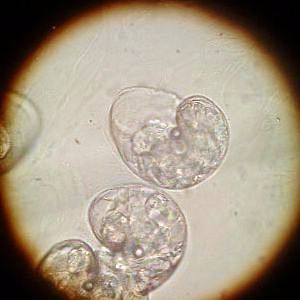
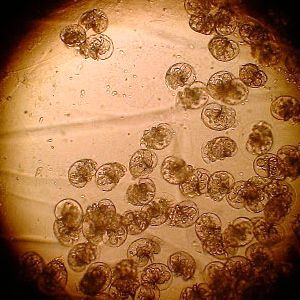
Hi, I have just seen your pages concerning Polycera quadrilineata and thought that you may be interested in the attached jpegs of its larval form.
The larva are a little dessicated but a gerneral idea of the body plan can be seen.
Yours
Nick Hudson
nicknicely@hotmail.com
Hudson, N., 2001 (Oct 27) Larvae of Polycera quadrilineata. [Message in] Sea Slug Forum. Australian Museum, Sydney. Available from http://www.seaslugforum.net/find/5415Thanks Nick,
I'd be interested to know how you came by the larvae? Are you studying them by chance, if so I am sure you would have an interested audience if you were to tell us a bit about your work
Best wishes,
Bill Rudman
Polycera quadrilineata from Holland
August 6, 1999
From: Peter van Bragt
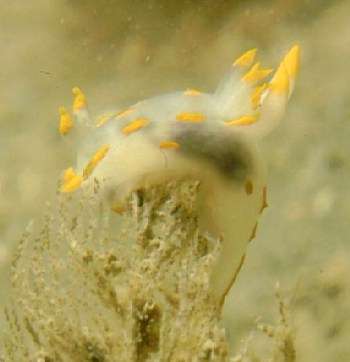
Dear Bill,
Here is a slide of Polycera quadrilineata from my collection of Dutch nudibranchs.
Location: Plompe toren, de Oosterschelde, the Netherlands
Peter H. van Bragt
Peter.vanBragt@ftn.hsbrabant.nl
van Bragt, P.H., 1999 (Aug 6) Polycera quadrilineata from Holland. [Message in] Sea Slug Forum. Australian Museum, Sydney. Available from http://www.seaslugforum.net/find/1149Dear Peter,
I have put this species up as the first of your collection of Dutch nudibranchs. When people from cooler climates complain that all the beautiful nudibranchs live in the tropics, Polycera quadrilineata is one of the species I use to prove them wrong.
I think this was the first European nudibranch I saw alive. I was on a collecting trip with Tom Thompson in South Wales and we went to a place he said was one of his best collecting spots. It was in the middle of a seaport, Milford Haven I think, and I will never forget him trying to tempt me into an oil-slicked patch of freezing water in south Wales. Finally he agreed the water was indeed freezing and full of oil and we retreated to a small marine station nearby, where they had some recently caught Polycera quadrilineata to honour Tom's visit. I don't know if it was my amazement at the beauty of the nudibranch, or my amazement when it finally dawned on me that Tom was really planning to enter the freezing polluted water, but I have never forgotten that collecting expedition, or the Polycera.
Bill Rudman.
Polycera quadrilineata from Wales
August 5, 1999
From: Daniel Geiger
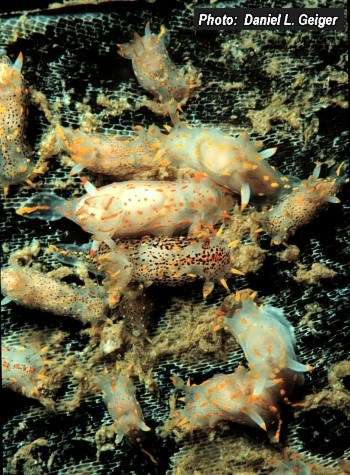
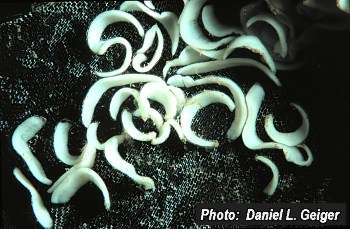
Dear Bill,
Here are some photos of Polycera quadrilineata showing colour variation and their egg masses.
Details are: Feeding on Membranipora membranacea on Laminaria digitata in Laminarian algae belt. United Kingdom, Wales, Swansea, Oxwich wreck, 24 June 1993, 1.2 metres.
Daniel Geiger
http://www.sbnature.org/geiger.
dgeiger@usc.edu
Geiger, D.L., 1999 (Aug 5) Polycera quadrilineata from Wales. [Message in] Sea Slug Forum. Australian Museum, Sydney. Available from http://www.seaslugforum.net/find/1148Dear Daniel,
Thanks for some more of your great photos. I have put some of them at the Top of the Page.
Best wishes,
Bill Rudman.
